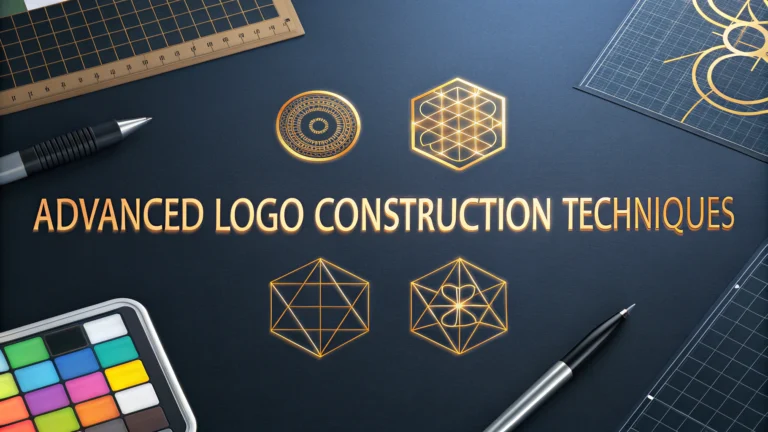Logo construction demands precision, creativity, and adherence to fundamental design principles that make brands memorable.
Creating professional logos requires mastering several key techniques, from grid systems to geometry.
Essential Grid Systems
Using a grid system ensures perfect alignment and proportion in logo design.
- Golden Ratio (1:1.618)
- Rule of Thirds
- Modular Grid Systems
Vector Construction Methods
Working with vector tools in Adobe Illustrator or similar software allows for infinitely scalable logos.
- Pen Tool mastery for precise curves
- Shape Builder tool for combining elements
- Pathfinder operations for complex shapes
Typography Integration
Text elements need careful consideration in logo design.
- Convert text to outlines
- Adjust kerning manually
- Create custom letterforms when needed
Color Theory Application
Professional logos work in both color and monochrome.
- Test designs in black and white first
- Use Pantone colors for consistency
- Consider color psychology
Geometric Precision
Geometry forms the backbone of strong logo design.
- Use perfect circles and squares
- Maintain consistent angles
- Apply geometric progression
File Preparation
Proper file organization ensures logos work across all applications.
- Save in multiple formats (AI, EPS, SVG, PNG)
- Create versions for different sizes
- Prepare both RGB and CMYK versions
Contact professional design organizations like AIGA (www.aiga.org) for additional resources and networking opportunities.
Common Construction Mistakes to Avoid
- Inconsistent stroke weights
- Poor spacing between elements
- Reliance on effects instead of solid construction
- Overly complex designs that don’t scale well
Test your logo designs at multiple sizes, from favicon to billboard scale, to ensure versatility.
| Format | Use Case |
|---|---|
| Vector (AI/EPS) | Print, Signage |
| PNG | Digital, Web |
| SVG | Responsive Web |
Logo Versatility Testing
Every professional logo must undergo rigorous testing across multiple platforms and scenarios.
- Social media profile compatibility
- Print material visibility
- Digital screen rendering
- Mobile device legibility
Brand Guidelines Integration
Logos must work within comprehensive brand systems.
- Clear space requirements
- Minimum size specifications
- Background compatibility rules
- Usage restrictions documentation
Client Presentation
Professional presentation of logo concepts enhances client understanding and approval rates.
- Real-world mockups
- Digital and print examples
- Animation demonstrations
- Brand implementation scenarios
Conclusion
Successful logo construction combines technical precision with creative vision. Designers must master grid systems, vector tools, typography, and color theory while maintaining geometric accuracy and proper file preparation. Regular testing and adherence to brand guidelines ensure logos remain effective across all applications.
Remember these key takeaways:
- Start with solid geometric foundations
- Maintain consistency in all technical aspects
- Test thoroughly across multiple platforms
- Prepare comprehensive file formats
- Document usage guidelines clearly
Stay current with industry standards and continuously refine your technical skills to create enduring logo designs that serve their intended purpose effectively.
FAQs
- What are the essential principles of advanced logo construction?
Advanced logo construction relies on core principles like grid systems, golden ratio, proper scaling, geometric precision, symmetry balance, and modular design to ensure logos remain consistent and effective across all applications. - How important is vectorization in advanced logo design?
Vectorization is crucial as it allows logos to be infinitely scalable without losing quality. All professional logos must be created in vector format using software like Adobe Illustrator to ensure versatility across different mediums. - What role does negative space play in advanced logo design?
Negative space is a sophisticated design element that creates dual imagery or hidden meanings within logos. It requires precise construction to ensure both the primary and secondary elements are clearly visible and meaningful. - How do you ensure logo consistency across different platforms?
Logo consistency is maintained through detailed brand guidelines, proper spacing rules, color specifications (CMYK, RGB, Pantone), minimum size requirements, and clear instructions for different background applications. - What are the most effective tools for precise logo construction?
Professional designers use Adobe Illustrator, Affinity Designer, or CorelDRAW for vector creation, along with digital tools like perspective grids, alignment guides, and pathfinder operations for precise shape construction. - How do you create a responsive logo system?
Responsive logos require designing multiple variations (simplified versions) that maintain brand recognition while adapting to different sizes and contexts, from favicon to billboard dimensions. - What mathematical principles are used in advanced logo construction?
Advanced logos often incorporate the golden ratio (1:1.618), geometric progression, perfect circles and squares, and precise angular measurements to create harmonious and balanced designs. - How do you protect logo construction against unauthorized modifications?
Protection involves creating comprehensive usage guidelines, providing locked vector files, embedding metadata, and registering trademarks to maintain logo integrity and prevent unauthorized alterations. - What role does typography play in advanced logo construction?
Typography in logos often requires custom letter spacing, kerning adjustments, and sometimes complete letter reconstruction to achieve perfect balance and unique character relationships. - How do you ensure a logo works in monochrome?
Every professional logo must be designed to function in single color by focusing on form, contrast, and proper weight distribution, ensuring it remains effective when color isn’t an option.







